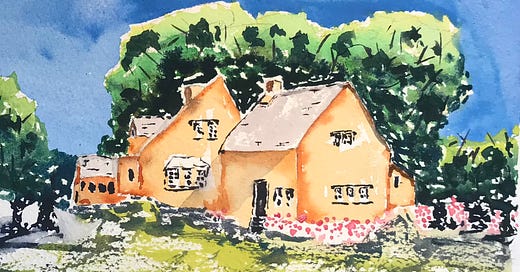This story could begin with “Once upon a time,” for what you are about to read is magical.
When Henry and Clara Ford visited an English village named Chedworth in Southwest England in the 1920s, they were enraptured by the village and one house in particular, the Rose Cottage. The cottage was located in the Cotswold region in England. As if transported back in time, their eyes gazed upon a stone building with a pink hue. It was christened Rose Cottage by the original owners. Upon closer inspection, the great inventor who transformed transportation and automated automobile assembly was captivated by the structure. To the touch, the stone had the texture of rough sandpaper. On close inspection, he saw that the stone was not pink but yellow-brown - An idea formulated in his mind. The man who worshiped at the altar of modernity also cared deeply about the past. He would save this structure and preserve the past for future generations.
Before the decade ended, Ford purchased the stone cottage for $5,000. A man of vision, he didn’t purchase the building without a plan. And, like most of his grand plans, this one was just as grand and spectacular. He would move Rose Cottage from its location in the Cotswold Region to Dearborn, Michigan. Upon hearing the plan, many on both sides of the Atlantic were skeptical, “That will never work.”
Rose Cottage was built in the early 1600s. In the year 1625, after his father's death, King Charles ascended to the English throne. His father, James, was twice king: first in Scotland, where he was King James VI, and then in England, where he reigned as King James I. During those years, the first stone was cut from the earth and levered onto a sledge. Secured with large ropes, the sledge, similar to a modern-day toboggan, was pulled by four oxen across the hills and valleys of Southwest England in the county of Gloucestershire. Upon arrival in Chedworth, the yellow-brown colored stone was carefully positioned. As a cornerstone, it would be the first among the many stones required to build the structure.
The first steps of Ford’s plan were implemented in early 1930. Rose Cottage was dismantled stone by stone and beam by beam. Keystones were numbered so that, like a puzzle, they could be reunited at their new location in Dearborn, Michigan. Photographs inside and outside the cottage were taken to aid the reconstruction. The stones were placed into gravel sacks, which numbered 506. The doors, windows, and staircases were carefully packed into 211 crates. The sacks and crates were loaded onto 67 railway cars. The components weighed 475 tons and included some Cotswold sheep that were also purchased and shipped along with everything else.
The railway cars carried the pieces of the Rose Cottage to the coast. The crates were loaded onto a ship that sailed to New York. Upon arrival, the cargo was transferred to railway cars. Finally, after a long journey, the disassembled Rose Cottage arrived at its new home in Greenfield Village in Dearborn. Ford left nothing to chance. He had hired a stonemason, Tom Troughton, and a carpenter, William Ratcliffe, to supervise the deconstruction and reconstruction. Rose Cottage was reconstructed in three months. In September of 1930, the project was complete, and the yellow-brown stone structure was given a new name, Cotswold Cottage.
Like any fairytale, a surprise is discovered in the story. It’s not with the characters; few had more vision than Ford. It’s not found with the craftsman Troughton or Ratcliffe, for there were no better craftsmen in the land. It’s not the manpower, railways, railcars, or ships. Long before the sheepherders who were the original occupants, King Charles the First, or his father, King James, twice king, the stone lay waiting during the 8th century when the land was referred to as the Anglo-Saxon Kingdoms: Wessex, Mercia, Northumbria, and East Anglia. It waited still during the Roman occupation from 43AD to 410AD.
The surprise is the stone. The surface of the stone has the texture of coarse sandpaper. Sedimentary rock and limestone formed during the Jurassic period, when giant plant-eating dinosaurs roamed the earth, and meat-eating carnivores hunted them. The Cotswold stone was developed in a marine environment inhabited by tiny shell creatures. It is known as oolitic limestone or “egg stone.” The fairytale appearance resulted from mineral deposits, which produce a pink tint when combined with water containing high iron levels. Chemistry buffs are now rejoicing because magic is once again foiled.
Don’t tell that to the stones that once were in contact with dinosaurs, saw the rise and fall of kings and nations, traveled thousands of miles by land and sea, and now await your touch while they sit and live happily ever after in a garden where tea party guests admire their beauty.





Thank you for your comment. I learned a great deal researching for the story. It is my favorite house at Greenfield Village.
I enjoy connecting art with writing. I hope to do more of this in the future. Thank you for your comment.